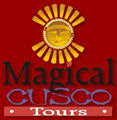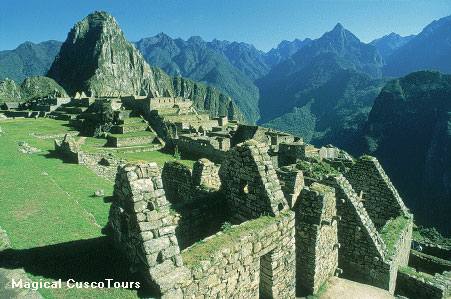 |
| Click On This Photo For Professional High Quality Peru Tours From Magical Cusco Tours Just Mention delange.org With Code Inka2010 Get A 4% Tour Discount With Any Package Tour Purchase! |
|---|
or
"Huaca de la Luna"
"House Of The Sun"
or
"Huaca del Sol".
Peru; Travels And Tours
Photos, Pictures, Images, & Reviews.
Google Map To The "Huaca del Sol" and
"Huaca de la Luna" Near Trujillo, Peru.
View Larger Map
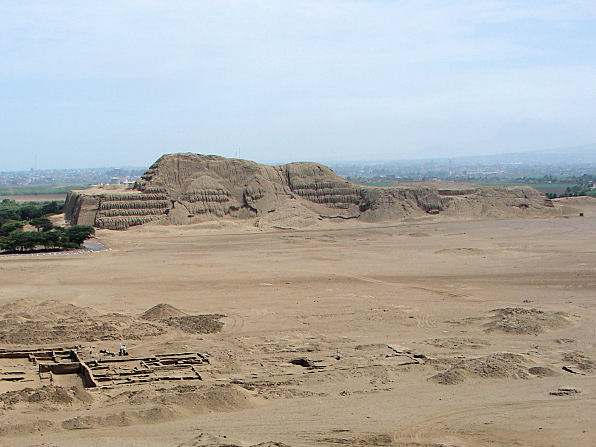 |
| House Of The Sun Or "Huaca del Sol" |
|---|
 |
| House Of The Moon Or "Huaca de la Luna" "Cerro Blanco", The White Mountain In The Background |
|---|
 |
| Close Up View Of The House Of The Sun Or "Huaca del Sol" |
|---|
 |
| Detail Of The Bricks Used In The House Of The Sun Or "Huaca del Sol" Estimates Are Between 50 Million To 100 Million Adobe Bricks Used |
|---|
 |
| Close Up View Of The House Of The Moon Or "Huaca de la Luna" |
|---|
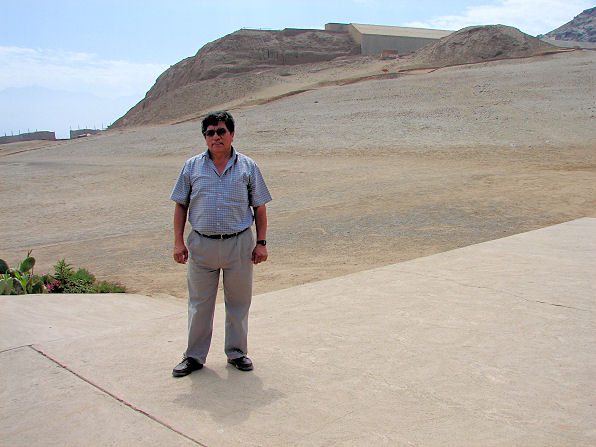 |
| Lic. Dr. Ricardo Morales Gamarra, Project Director, Director of Conservation, Greets Us For Our Visit |
|---|
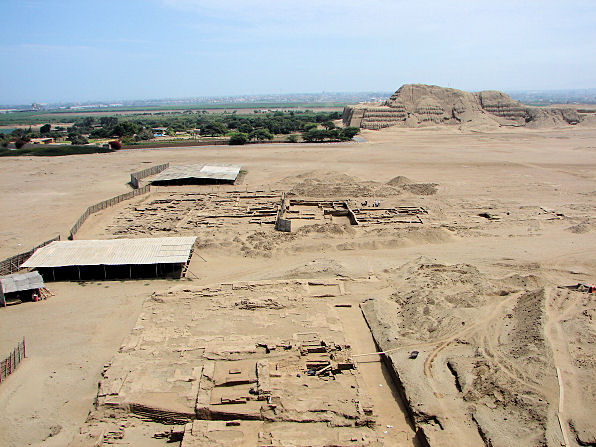 |
| "Huaca del Sol" And "Huaca de la Luna"; Urban, Manufacturing Area. |
|---|
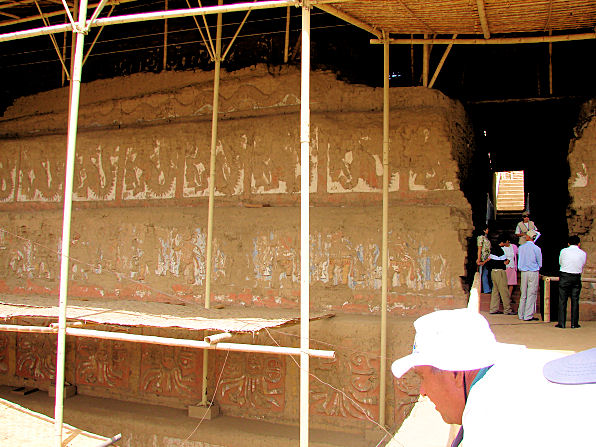 |
| "Huaca de la Luna"; "Ceremonial Plaza", South Side Of "North Facade" Area. |
|---|
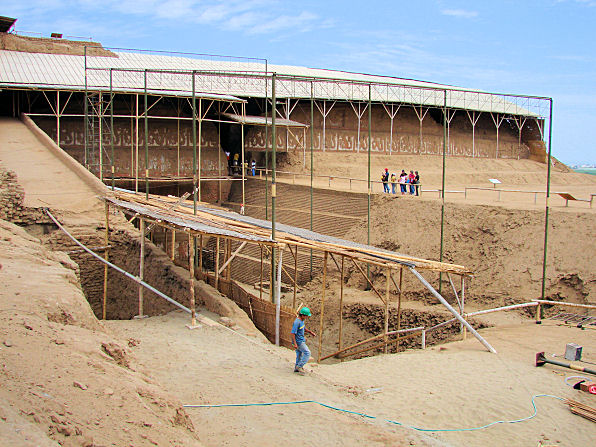 |
| "Huaca de la Luna"; "Ceremonial Plaza", South Side Of "North Facade" Area. |
|---|
The Huaca del Sol & The Huaca de la Luna The primary structures are two huge adobe brick platforms: the Pyramid of the Sun, or Huaca del Sol, and the artificial platform called Huaca de la Luna, or Temple of the Moon. Within the 1/4 milewide, open plain between them, researchers have found many graves, as well as evidence of large scale manufacturing covered by a layer of sediment up to 10 feet thick. A considerable number of people were living at this great settlement. It is located so as not to usurp agricultural land and it is in a good location to acquire food, building materials and other resources.
The Huaca del Sol In 1602 the Spaniards looking for gold treasure; intentionally diverted the Santa Catalina River, into the pyramid which then washed away more than 1/2 of the Huaca del Sol on the west side. It is estimated that approximately 2/3 of the structure has been lost to erosion and looting. The Huaca del Sol stepped pyramid is made up of four main platforms that rise up from the northeast, where an access ramp would have stood, toward the southwest where there is a fourth, lower and narrower platform. It is made up entirely of sun-dried adobe bricks. Many of the adobe bricks have their original brick mason marks, such as imprints of hands, feet, dots, crosses upon them. These marks have been interpreted by researchers as accounting tools to distinguish different groups of brick masons, which facilitated tracking the payment of “taxes”. The number of different maker’s marks on the bricks suggests that over a hundred different communities contributed bricks to the construction of the Huacas. The use of brick mason marks is also evident at a Mesoamerican site in Tabasco Mexico called Comalcalco. The name “Huaca del Sol” is really not known since there are no indications as to what was the original name of the site, which must have been in the now-extinct Muchik language, spoken here during the 15th Century. It is believed today that the Huaca del Sol may have been a burial mound for Moche rulers, while the Huaca de la Luna served a largely ceremonial and religious function, though it contains burials as well.
The Huaca de la Luna The Pyramid or Temple of the Moon has three platforms and four open courts or plazas making up most of the structure, which is built against the lower slopes of the Cerro Blanco or White Mountain. All of the bricks used in the Huaca de la Luna also bear one of ninety-three different markings, each one corresponding to a group of laborers. Each group was assigned a mark to put on their bricks. The Temple of the Moon measures 950 feet from north to south and 690 feet from east to west. The access to the structure was probably located on the north side Looters have tunneleds into its' eastern side and exposed many polychrome reliefs, which are now destroyed. Many Moche burials, have been excavated inside the massive adobe platform which have produced artifacts, such as ceramics and metal headgear. The Huaca de la Luna itself is a large complex of three main platforms, each one serving a different function. Very tall and wide walls mark off each of the four courts, some of the which have narrow cane and pole roofs running along the sides. The Huaca de la Luna was decorated in murals which were painted in black, bright red, white, and yellow. The sun and weather has since faded these murals away, but other murals used in earlier phases of construction can still be seen inside the Huaca. Many of these depict a deity now known as Ayapec. "Ayapec" is a Quechua word translating as "Wrinkle-Face;" this name was given to the deity by the later Inca because of the deity's appearance. Painted reliefs have also been located in several of the platforms and plazas. For example, the head of the "degollador" or sacrificer, decorates the walls of platform I in the southwest corner of the site. The large southern platform was the site of human sacrifice rituals. The open space between the two pyramids has recently been found to have been an area of manufacturing. Ceramic workshops and large-scale maize-beer production are evident as well as textile production and metalworking. IF YOU LOVE WATCHING ARCHAEOLOGY ACTIVITIES TAKING PLACE. THEN THIS IS THE SITE TO VISIT.You can "feel" the excitement in the air as you watch the many restorations and digs actually taking place as you visit. As you look over our photos, look also for the many activities going on at the site. We found the management, workers, and volunteers to be very honest and excited in the work that they are doing here. We found these people to be doing extraordinary things with the limited funds that they have to work with. If you wish to make a donation of time or money to help with these activities, your donation will be welcome and actually be put to good use, to make the "Huaca del Sol" and "Huaca de la Luna" archaeological site even better. A link to their donation contact page is at the bottom of this page.
We were at the "Huaca del Sol" and "Huaca de la Luna" on April 27, 2006 during the morning from 11:00 AM until about 12:45 PM.
|
The first choice of where to go in order to visit The Huacas del Sol and de la Luna ("Huacas" of the Sun and of the Moon) is to fly in to Trujillo. The Huacas del Sol and de la Luna are only about 5 kilometers south of Trujillo Trujillo is a moderately large city in Northwestern Peru, very close to the Pacific Coast. Trujillo is known for its seafood and the beaches of its famous surf and beach resort Huanchaco. The Capitán FAP Carlos Martínez de Pinillos International Airport (IATA: TRU, ICAO: SPRU); known as Aeropuerto Internacional Capitán FAP Carlos Martínez de Pinillos in Spanish, is the airport serving Peru's third most important city, Trujillo. It is the main air hub in northern Peru. The second choice is Chiclayo, which is the capital city of the Lambayeque region in northern Peru. It is located 13 kilometers inland from the Pacific coast and 770 kilometers from the nation's capital, Lima. Chiclayo is one of the most important urban areas of Peru. It has grown to become the country's fourth largest city after Lima, Arequipa, and Trujillo. Chiclayo is very commercialized and has many modern characteristics. It is known as one of the friendliest cities in Peru. Because of this attribute, Chiclayo is known as, "The Capital of Friendship and the Pearl of the North." The Capitán FAP José A. Quiñones Gonzales International Airport (IATA: CIX, ICAO: SPHI) is the airport serving Chiclayo, Peru and the surrounding metropolitan area. It is run by CORPAC S.A. (Corporación Peruana de Aeropuertos y Aviación Comercial S.A.), a government-run organization that oversees the management of Peruvian airports. It is the main airport of the Lambayeque Region, one of the most populous of the country. There are several Guided Tour Agencies offering standard city, and archaeological tours of Trujillo or Chiclayo and the surrounding area.
This page is for information purposes only and while we have made every effort to be accurate, it is the travelers responsibility to make the appropriate choice as to which hotels to use in Peru.
We found that when touring Peru, Magical Cusco Tours gave us the best service of all. They even arranged very personal tours based upon our ages and experience. They were there for us whenever we needed them. Click on any of their links on our pages and they will give you a 4% discount for taking their package tours. Mention delange.org. Merchant Code Inka2010 for your discount! We suggest letting Ana Maria handle your tour. Note: The 4% discount applies to package tours only! Discount does not apply to hotel bookings, domestic or international tickets, meals or any other service booked as a single activity.
Magical Cusco Tours also has a culinary tour that you may enjoy.Click Here For: Taste Of Peru.com their culinary tour page.
We also have links to Priceline.Com on our pages, in case you may prefer to use their services.
|

We're Glad You Stopped By! Come back soon!
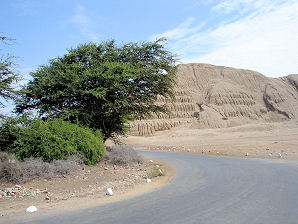 | 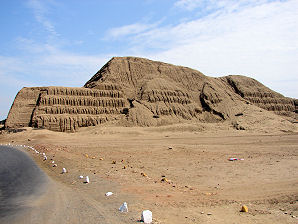 |
| We Enter The Site From Our Left Between The Tree & Sun House | We See The House Of The Sun |
|---|---|
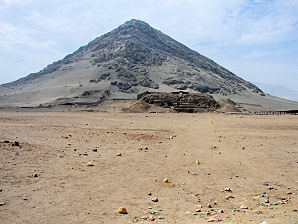 | 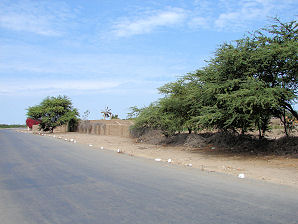 |
| We See The House Of The Moon | We Take This Road To The Museum & Moon House |
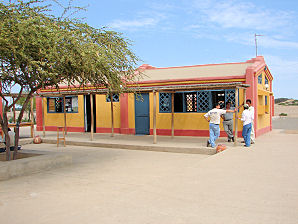 | 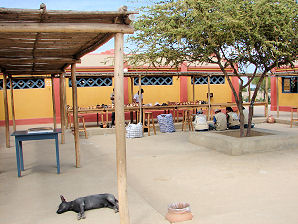 |
| We Stop At The Site Museum And Snack Bar | Here We See Tour Guides And Tourist Goods |
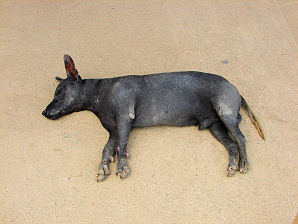 | 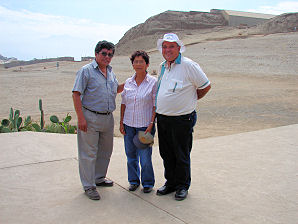 |
| And The Very Alert Guard Dog A Peruvian Hairless Dog | Lic. Dr. Ricardo Morales Gamarra Project Director, Director of Conservation Edith Muñoz Our Tour Guide And George DeLange Photo By Audrey DeLange |
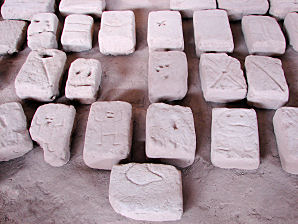 | 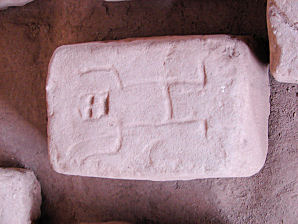 |
| Adobe Bricks Used In The Temple Construction Making Bricks Was A Form Of Taxation | Brickmason Marks On The Adobe Brick Designate Family Or Community Performing Work. |
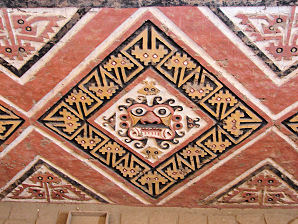 | 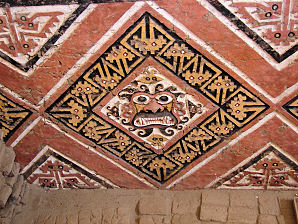 |
| The God Ai Apaec Or Decapitator God On Ediface D | The God Ai Apaec Or Decapitator God On Ediface D |
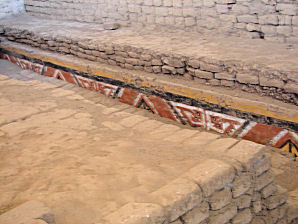 | 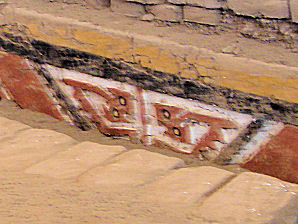 |
| Stair Step Design | Stair Step Design |
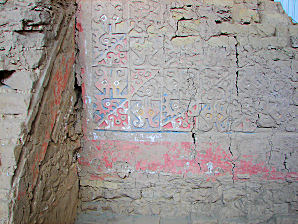 | 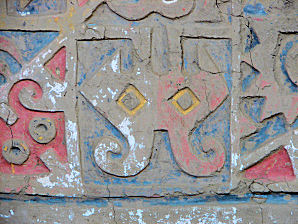 |
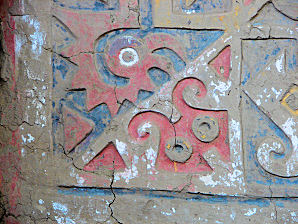 | 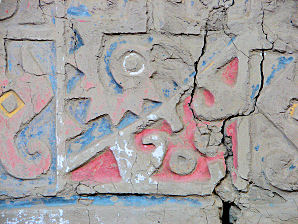 |
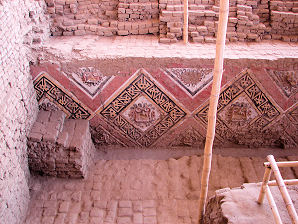 | 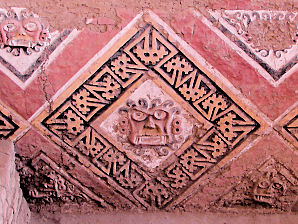 |
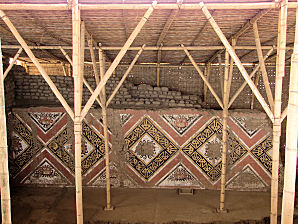 | 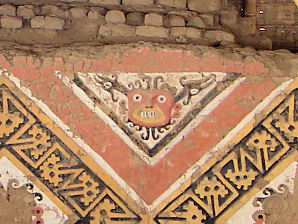 |
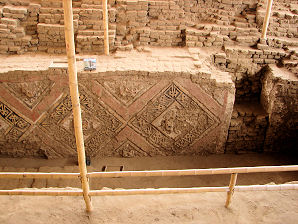 | 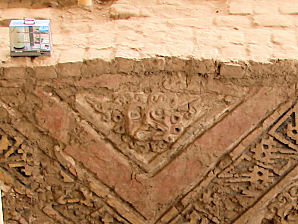 |
| The God Ai Apaec Or Decapitator God On Ediface B/C | The God Ai Apaec Or Decapitator God On Ediface B/C |
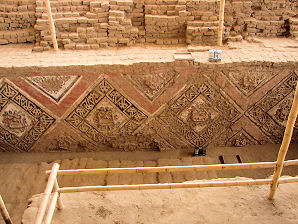 | 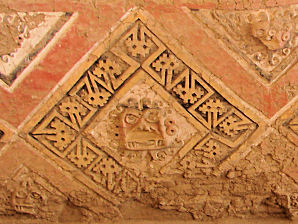 |
| The God Ai Apaec Or Decapitator God On Ediface B/C | The God Ai Apaec Or Decapitator God On Ediface B/C |
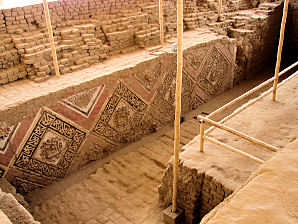 | 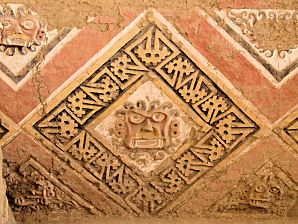 |
| The God Ai Apaec Or Decapitator God On Ediface B/C | The God Ai Apaec Or Decapitator God On Ediface B/C |
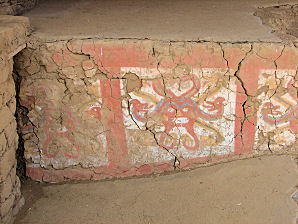 | 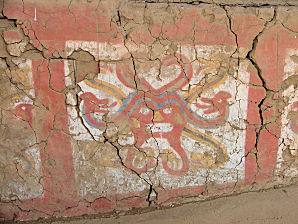 |
| Octopus Decapitator God | Octopus Decapitator God |
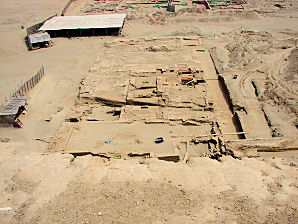 | 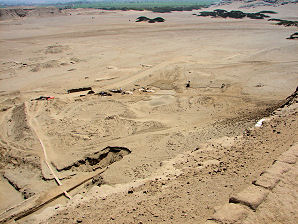 |
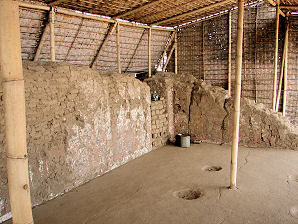 | 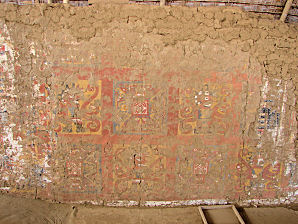 |
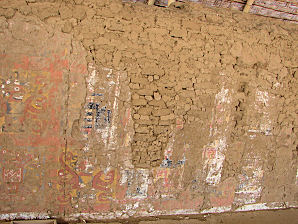 | 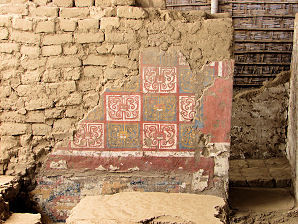 |
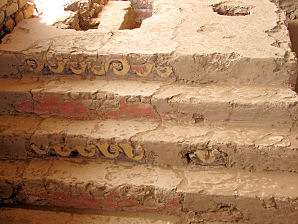 | 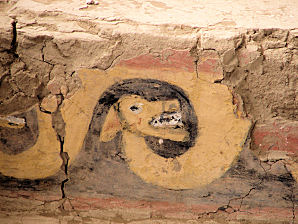 |
| Snake Stair Step Design | Snake Stair Step Design |
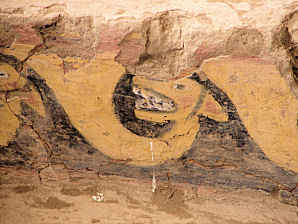 | 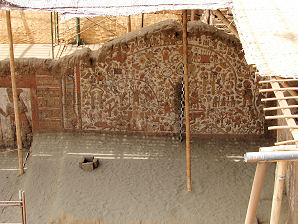 |
| Snake Stair Step Design | Celestial View |
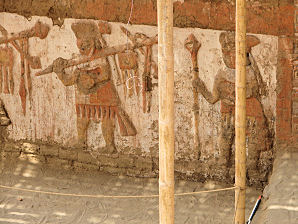 | 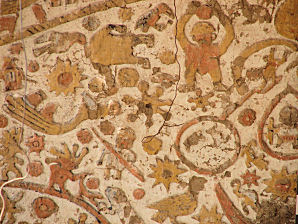 |
| Celestial View | |
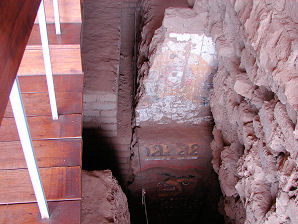 | 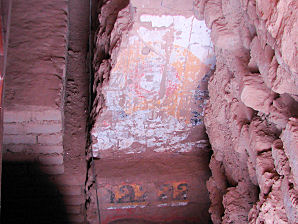 |
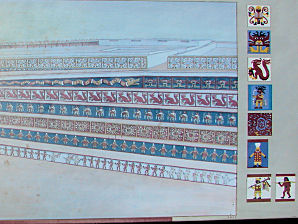 | 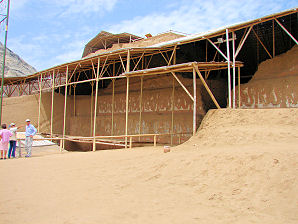 |
| "Huaca de la Luna", "Ceremonial Plaza" South Side Of North Facade Area Showing Levels Of Reliefs. | "Huaca de la Luna", "Ceremonial Plaza" South Side Of North Facade Area |
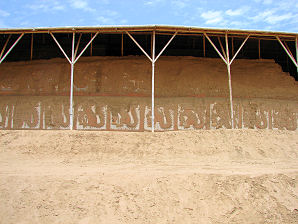 | 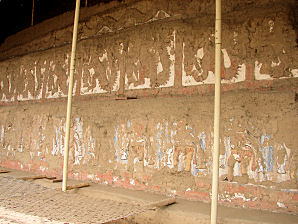 |
| "Huaca de la Luna", "Ceremonial Plaza" South Side Of North Facade Area | "Huaca de la Luna", "Ceremonial Plaza" South Side Of North Facade Area |
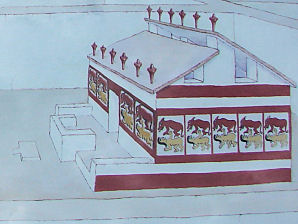 | 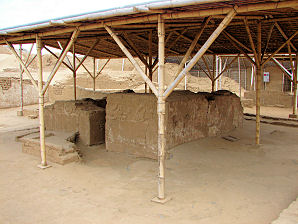 |
| Sacrificial Enclosures Areas Associated With Sacrifice Note: Puma Attacking Woman | Sacrificial Enclosures Areas Associated With Sacrifice |
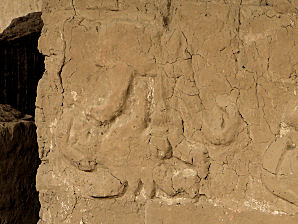 | 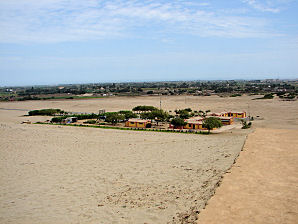 |
| Puma Attacking A Woman Facade On Sacrifical Enclosure | Museum, Snack Bar, Souvenirs Shops, & Offices |
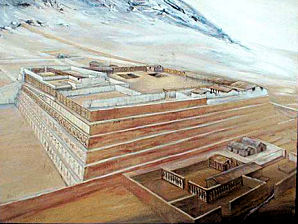 | 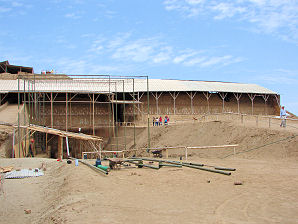 |
| Artist Drawing Of "Huaca de la Luna" | South Side Of North Facade |
We Are Proud Of Our SafeSurf Rating!

Click On Any Of The Following Links By Amazon.Com
For Books About Hiking Or Touring In Peru.
Some Are Must Have Books - If You Are Going To Peru.
We Also Are Including Some Great Music CD's & DVD's. No Obligation!

Back To Peru Home Page
Back To DeLange Home Page






